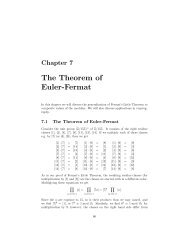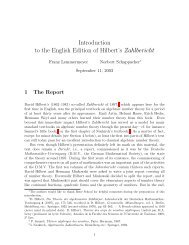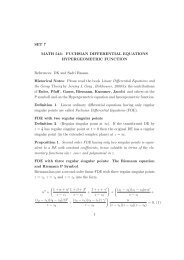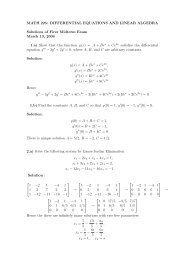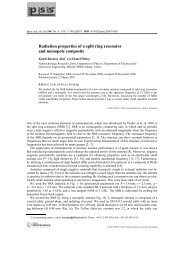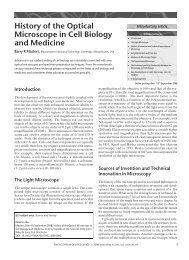Correlation of histology and linear and nonlinear microscopy of the ...
Correlation of histology and linear and nonlinear microscopy of the ...
Correlation of histology and linear and nonlinear microscopy of the ...
You also want an ePaper? Increase the reach of your titles
YUMPU automatically turns print PDFs into web optimized ePapers that Google loves.
Journal <strong>of</strong><br />
BIOPHOTONICS<br />
136<br />
B. R. Masters: <strong>Correlation</strong> <strong>of</strong> <strong>histology</strong> <strong>and</strong> <strong>linear</strong> <strong>and</strong> non<strong>linear</strong> <strong>microscopy</strong> <strong>of</strong> <strong>the</strong> living human cornea<br />
are fixed, stained with specific fluorescent probes,<br />
embedded <strong>and</strong> sectioned.<br />
Finally, it is proposed that correlative <strong>microscopy</strong><br />
become <strong>the</strong> st<strong>and</strong>ard procedure to validate <strong>the</strong><br />
images that are obtained with <strong>linear</strong> <strong>and</strong> non<strong>linear</strong><br />
<strong>microscopy</strong>. It is proposed to develop a new clinical<br />
imaging system that may be based on several new<br />
types <strong>of</strong> <strong>linear</strong> <strong>and</strong> non<strong>linear</strong> microscopies; i.e. confocal<br />
reflected light <strong>microscopy</strong> with multispectral<br />
sources based on arrays <strong>of</strong> LEDs, multiphoton excitation<br />
<strong>microscopy</strong> based on cellular NAD(P)H fluorescence,<br />
<strong>and</strong> second-harmonic <strong>microscopy</strong> based on<br />
signals from collagen fibers. During <strong>the</strong> development<br />
<strong>and</strong> validation with both ex vivo specimens, in vivo<br />
animal corneas, <strong>and</strong> finally clinical studies that have<br />
prior approval from institutional review boards<br />
(IRB) it is necessary that both <strong>the</strong> safety <strong>and</strong> <strong>the</strong> validity<br />
<strong>of</strong> <strong>the</strong> imaging techniques be subjected to strict<br />
scrutiny.<br />
In <strong>the</strong> transition from <strong>the</strong> laboratory to <strong>the</strong> clinic<br />
<strong>the</strong>re are several cautions to be addressed. It is important<br />
to compare <strong>the</strong> images <strong>of</strong> <strong>the</strong> cornea that<br />
are obtained with confocal <strong>microscopy</strong>, <strong>and</strong> those<br />
obtained with multiphoton excitation <strong>microscopy</strong><br />
<strong>and</strong> second-harmonic generation <strong>microscopy</strong>. The<br />
clinical in vivo reflected light confocal <strong>microscopy</strong><br />
images show a resolution <strong>and</strong> a signal-to-noise ration<br />
that is similar to <strong>the</strong> those from ex vivo specimens<br />
<strong>and</strong> have been fairly well validated with both optical<br />
<strong>microscopy</strong> <strong>of</strong> sectioned whole mounts <strong>of</strong> human<br />
cornea as well as with electron <strong>microscopy</strong> studies <strong>of</strong><br />
ex vivo human cornea.<br />
Much more work is required to validate <strong>the</strong> ex vivo<br />
<strong>and</strong> <strong>the</strong> in vivo corneal images that are acquired with<br />
<strong>the</strong> non<strong>linear</strong> microscopic techniques such as multiphoton<br />
excitation <strong>microscopy</strong> <strong>and</strong> second-harmonic<br />
generation <strong>microscopy</strong>. It is proposed to use correlative<br />
<strong>microscopy</strong> that consists <strong>of</strong> imaging <strong>the</strong> same<br />
corneal specimen with reflected light confocal <strong>microscopy</strong>,<br />
multiphoton excitation <strong>microscopy</strong>, second-harmonic<br />
generation <strong>microscopy</strong>, <strong>and</strong> electron <strong>microscopy</strong>,<br />
in order to validate <strong>and</strong> to reduce <strong>the</strong> ambiguity<br />
<strong>of</strong> spurious claims <strong>of</strong> structural interpretation.<br />
The various <strong>linear</strong> <strong>and</strong> non<strong>linear</strong> optical microscopic<br />
techniques differ in both <strong>the</strong> physics <strong>of</strong> contrast<br />
generation, <strong>the</strong> deposition <strong>of</strong> energy in <strong>the</strong> specimen,<br />
<strong>and</strong> <strong>the</strong> potential for cell damage during<br />
image acquisition [44]. Confocal <strong>microscopy</strong> that operates<br />
in <strong>the</strong> reflected light mode generates contrast<br />
from spatial variation in <strong>the</strong> refractive index within<br />
<strong>the</strong> specimen. Boundaries with large differences <strong>of</strong><br />
refractive index, such as scar in <strong>the</strong> cornea are highly<br />
scattering <strong>and</strong> large signals are generated in <strong>the</strong><br />
back-scattering direction which is optimal for a noninvasive<br />
instrument to image <strong>the</strong> in vivo cornea.<br />
Before non<strong>linear</strong> optical techniques can be approved<br />
for routine clinical examination <strong>of</strong> <strong>the</strong> patient’s<br />
cornea <strong>the</strong>re are several concerns that must be<br />
addressed. The first concern is patient safety. While<br />
two photon excitation <strong>microscopy</strong> <strong>of</strong> <strong>the</strong> cornea can<br />
provide functional imaging <strong>the</strong> process does deposit<br />
energy into <strong>the</strong> tissue. Studies <strong>of</strong> animal corneas,<br />
<strong>and</strong> ex vivo human corneas are needed to address<br />
safety issues. Cell <strong>and</strong> tissue damage as a functions<br />
<strong>of</strong> pulse width, laser repetition rate, laser frequency,<br />
<strong>and</strong> peak pulse power are required to meet FDA approval<br />
for a new medical device. Non<strong>linear</strong> harmonic<br />
generation may prove to be <strong>the</strong> least damaging to<br />
cells <strong>and</strong> tissue since <strong>the</strong>re is no net deposition <strong>of</strong><br />
energy into <strong>the</strong> tissue.<br />
While <strong>the</strong> <strong>linear</strong> corneal imaging systems use<br />
ei<strong>the</strong>r incoherent lamps or coherent continuous<br />
lasers as <strong>the</strong> light source, non<strong>linear</strong> imaging systems<br />
typically require expensive femtosecond lasers.<br />
Therefore, non<strong>linear</strong> optical microscopes are much<br />
more expensive.<br />
Much <strong>of</strong> <strong>the</strong> work with non<strong>linear</strong> optical <strong>microscopy</strong><br />
is based on two techniques: (1) multiphoton<br />
excitation <strong>microscopy</strong> that is based on two-photon<br />
excitation <strong>of</strong> ei<strong>the</strong>r intrinsic fluorescent molecules<br />
such as NAD(P)H [43], or genetically over expressed<br />
green fluorescent, or extrinsic fluorescent<br />
molecules, or (2) second-harmonic generation <strong>microscopy</strong>.<br />
Multiphoton excitation <strong>microscopy</strong> is based<br />
on <strong>the</strong> non<strong>linear</strong> absorption <strong>of</strong> incident energy to<br />
form excited electronic states <strong>and</strong> <strong>the</strong> subsequent<br />
emission <strong>of</strong> fluorescence. One <strong>the</strong> o<strong>the</strong>r h<strong>and</strong>, second-harmonic<br />
generation <strong>microscopy</strong> is a non<strong>linear</strong><br />
scattering process (predominately in <strong>the</strong> forward<br />
direction) <strong>and</strong> <strong>the</strong>refore, <strong>the</strong>re is no energy deposition<br />
in <strong>the</strong> specimen. If second-harmonic generation<br />
<strong>microscopy</strong> is to become a clinical imaging modality<br />
for imaging <strong>the</strong> in vivo cornea, <strong>the</strong>n it is imperative<br />
that new techniques be developed to enhance <strong>the</strong><br />
back-scattered component <strong>of</strong> <strong>the</strong> SHG signal.<br />
Fur<strong>the</strong>rmore, while multiphoton excitation <strong>microscopy</strong><br />
is useful for corneal functional imaging based<br />
on <strong>the</strong> fluorescence <strong>of</strong> <strong>the</strong> naturally occurring<br />
NAD(P)H, SHG <strong>microscopy</strong> is more restrictive. In<br />
SGH <strong>microscopy</strong> an incipient wave <strong>of</strong> frequency w<br />
generates a signal at <strong>the</strong> frequency 2w. The physics<br />
<strong>of</strong> <strong>the</strong> process shows that all even-order non<strong>linear</strong><br />
susceptibilities vanish in centrosymmetric materials;<br />
<strong>the</strong>refore, SHG occurs in materials with no inversion<br />
symmetry. SHG <strong>microscopy</strong> is especially suitable for<br />
<strong>the</strong> imaging <strong>of</strong> collagen fibers.<br />
Because <strong>the</strong> back scattered SHG signal from <strong>the</strong><br />
cornea is <strong>of</strong>ten weak <strong>the</strong> interpretation <strong>of</strong> SHG corneal<br />
images is <strong>of</strong>ten ambiguous. Published papers<br />
contain SHG images <strong>of</strong> <strong>the</strong> cornea with putative interpretations<br />
<strong>of</strong> structures within <strong>the</strong> cornea. Correlative<br />
<strong>microscopy</strong> that compares SHG <strong>microscopy</strong><br />
<strong>and</strong> electron <strong>microscopy</strong> would serve to reduce <strong>the</strong><br />
ambiguity <strong>of</strong> image interpretation.<br />
The interpretation <strong>of</strong> <strong>the</strong> SHG <strong>microscopy</strong> <strong>of</strong> collagen<br />
1 fibrils was investigated by Williams, Zipfel<br />
# 2009 by WILEY-VCH Verlag GmbH & Co. KGaA, Weinheim www.biophotonics-journal.org



